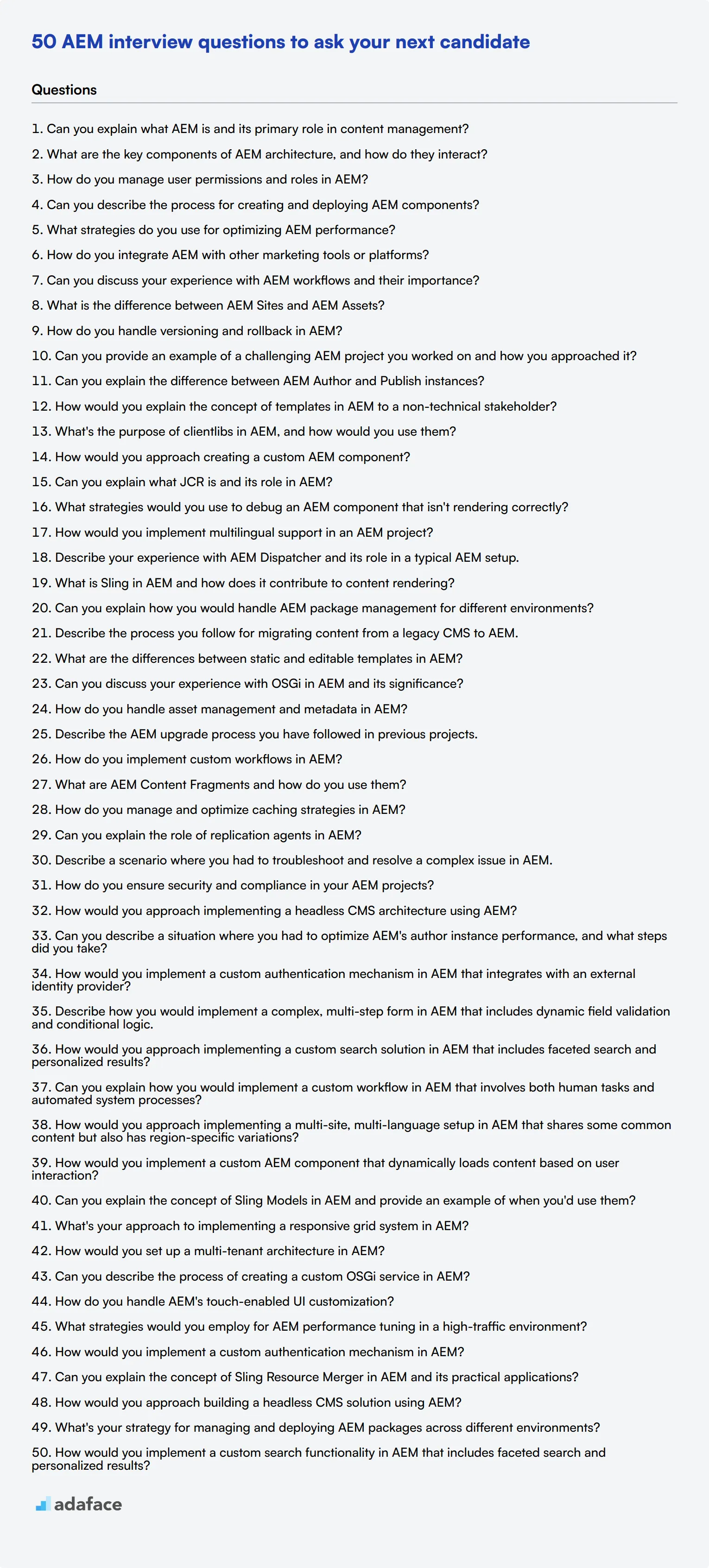Hiring the perfect candidate for an AEM developer role can be a challenge without the right set of interview questions. Properly targeted questions can make the difference in evaluating their expertise and skill level, ensuring they fit well with your team and project needs.
In this blog post, we provide tailored AEM interview questions and answers for different experience levels. The questions are categorized to help you assess candidates from junior to senior levels effectively during interviews.
Utilize this comprehensive list to streamline your interview process and make better hiring decisions. For a more thorough evaluation, consider using our Java-Spring-Hibernate test as a pre-interview assessment tool.
Table of contents
10 AEM interview questions to initiate the interview
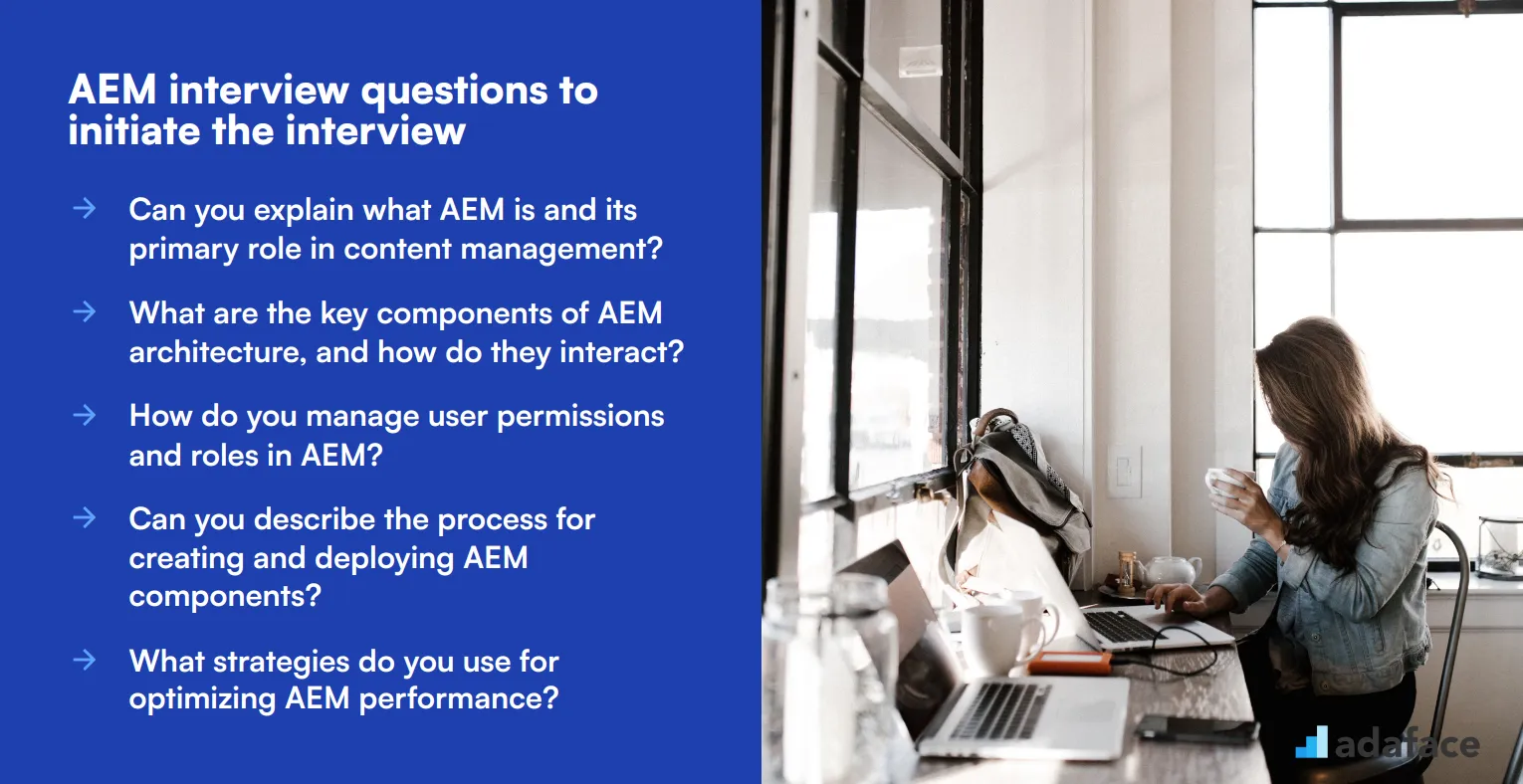
To assess candidates’ proficiency in Adobe Experience Manager (AEM), these 10 interview questions can help guide your discussion. Use them to evaluate not only their technical skills but also their understanding of practical applications in real-world scenarios. For more insights on job requirements, explore our software developer job descriptions.
- Can you explain what AEM is and its primary role in content management?
- What are the key components of AEM architecture, and how do they interact?
- How do you manage user permissions and roles in AEM?
- Can you describe the process for creating and deploying AEM components?
- What strategies do you use for optimizing AEM performance?
- How do you integrate AEM with other marketing tools or platforms?
- Can you discuss your experience with AEM workflows and their importance?
- What is the difference between AEM Sites and AEM Assets?
- How do you handle versioning and rollback in AEM?
- Can you provide an example of a challenging AEM project you worked on and how you approached it?
6 AEM interview questions and answers to evaluate junior developers
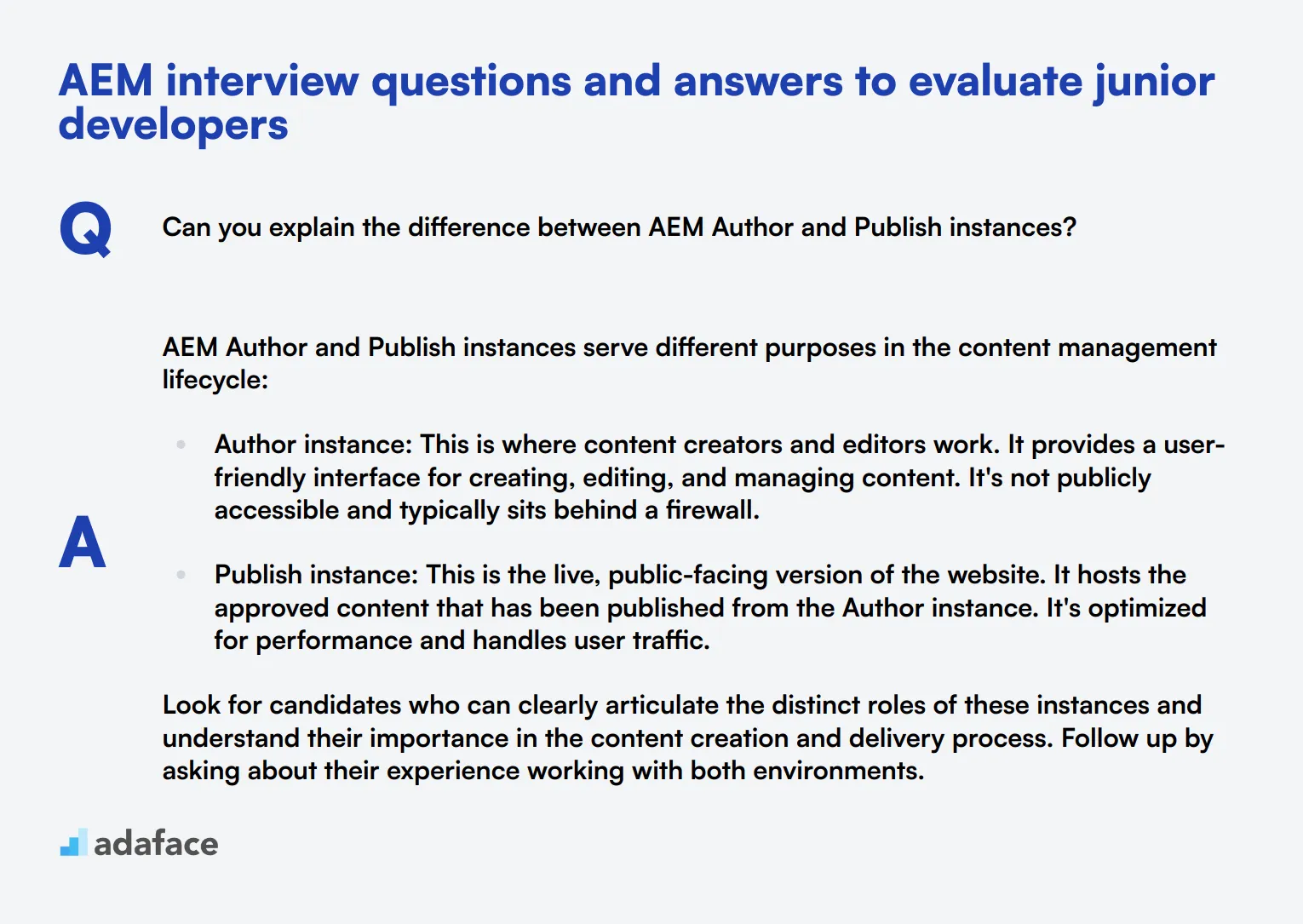
When evaluating junior developers for AEM positions, it's crucial to ask questions that gauge their foundational knowledge and problem-solving skills. This curated list of interview questions will help you assess candidates' understanding of AEM basics and their ability to think on their feet. Use these questions to spark discussions and gain insights into how well potential hires might fit into your AEM projects.
1. Can you explain the difference between AEM Author and Publish instances?
AEM Author and Publish instances serve different purposes in the content management lifecycle:
- Author instance: This is where content creators and editors work. It provides a user-friendly interface for creating, editing, and managing content. It's not publicly accessible and typically sits behind a firewall.
- Publish instance: This is the live, public-facing version of the website. It hosts the approved content that has been published from the Author instance. It's optimized for performance and handles user traffic.
Look for candidates who can clearly articulate the distinct roles of these instances and understand their importance in the content creation and delivery process. Follow up by asking about their experience working with both environments.
2. How would you explain the concept of templates in AEM to a non-technical stakeholder?
A strong answer should use an analogy or simple explanation, such as:
"Templates in AEM are like blueprints for a house. Just as a blueprint defines the basic structure and layout of a house, an AEM template defines the basic structure and layout of a web page. It sets up the foundation, determining where different elements like the header, footer, and main content area will go. This ensures consistency across multiple pages and makes it easier to create new pages quickly."
Look for candidates who can communicate technical concepts in an easily understandable way. This skill is crucial for junior developers who may need to interact with non-technical team members or clients.
3. What's the purpose of clientlibs in AEM, and how would you use them?
Clientlibs, short for client-side libraries, are a way to organize and manage CSS and JavaScript files in AEM. They serve several purposes:
- Organize front-end code: Clientlibs help keep CSS and JS files structured and maintainable.
- Manage dependencies: They allow developers to specify which scripts or styles should be loaded together.
- Optimize performance: AEM can use clientlibs to combine, minify, and cache resources, improving page load times.
A good candidate should be able to explain how they would create a clientlib, categorize it, and include it in a component or page. Look for understanding of the allowProxy property and how clientlibs are referenced in HTL (HTML Template Language).
4. How would you approach creating a custom AEM component?
Creating a custom AEM component involves several steps:
- Define the component's purpose and functionality.
- Create the component structure in the JCR (Java Content Repository).
- Develop the component's dialog for author input.
- Write the component's HTL script for rendering.
- Implement any necessary Java classes for backend logic.
- Style the component using CSS (often via clientlibs).
- Test the component in both Author and Publish environments.
Look for candidates who can outline this process and discuss best practices like keeping components modular, reusable, and following AEM's component guidelines. Ask follow-up questions about their experience with specific parts of this process, such as dialog configuration or HTL scripting.
5. Can you explain what JCR is and its role in AEM?
JCR stands for Java Content Repository. In AEM, it serves as the foundation for content storage and management. Key points a candidate should mention include:
- JCR is a hierarchical database that stores all content and configuration as nodes and properties.
- It provides versioning, access control, and querying capabilities.
- AEM uses Apache Jackrabbit Oak as its JCR implementation.
- Content, components, templates, and even application code are stored in the JCR.
A strong answer would also touch on how developers interact with the JCR, such as using CRXDE Lite for development or JCR queries for content retrieval. Look for candidates who understand the importance of JCR in AEM's architecture and can discuss its impact on content modeling and application development.
6. What strategies would you use to debug an AEM component that isn't rendering correctly?
Debugging an AEM component requires a systematic approach. A good answer might include the following strategies:
- Check the browser console for JavaScript errors.
- Inspect the HTML output to ensure the component markup is being generated.
- Use AEM's built-in debugger (accessing a page with ?debug=true).
- Review server logs for any backend errors or exceptions.
- Verify that all required clientlibs are being loaded correctly.
- Use breakpoints in the component's HTL or Java code.
- Ensure the component is properly configured in the template and page structure.
Look for candidates who demonstrate a logical troubleshooting process and familiarity with AEM's debugging tools. Ask follow-up questions about specific debugging experiences they've had with AEM components to gauge their practical knowledge.
15 intermediate AEM interview questions and answers to ask mid-tier developers
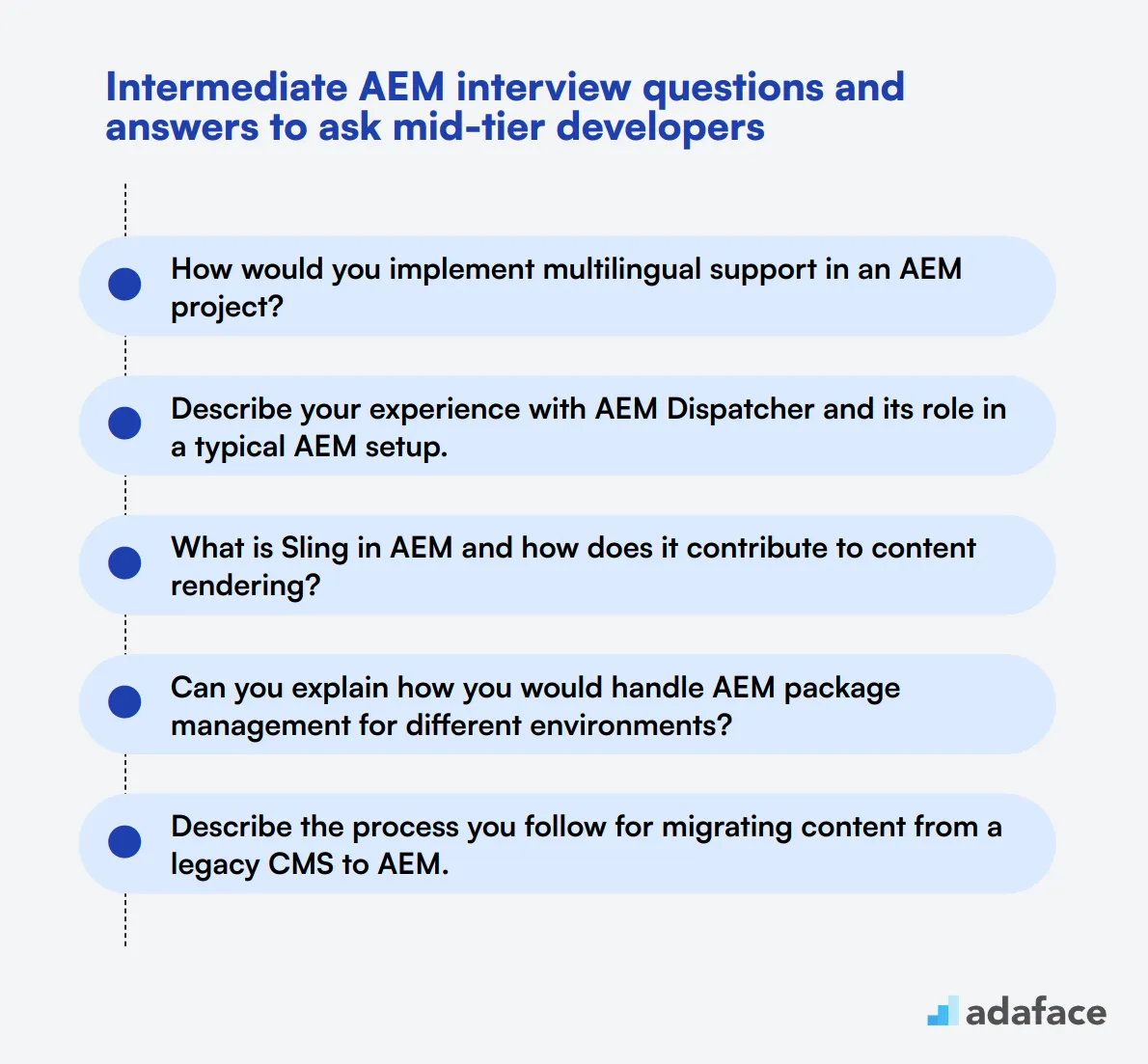
To assess whether your mid-tier developers have the necessary skills and experience with Adobe Experience Manager (AEM), use these 15 intermediate AEM interview questions. These questions are designed to gauge the candidate's deeper understanding of AEM and its applications, helping you make a well-informed hiring decision. For additional insights into what to look for in a developer, check out software developer job description.
- How would you implement multilingual support in an AEM project?
- Describe your experience with AEM Dispatcher and its role in a typical AEM setup.
- What is Sling in AEM and how does it contribute to content rendering?
- Can you explain how you would handle AEM package management for different environments?
- Describe the process you follow for migrating content from a legacy CMS to AEM.
- What are the differences between static and editable templates in AEM?
- Can you discuss your experience with OSGi in AEM and its significance?
- How do you handle asset management and metadata in AEM?
- Describe the AEM upgrade process you have followed in previous projects.
- How do you implement custom workflows in AEM?
- What are AEM Content Fragments and how do you use them?
- How do you manage and optimize caching strategies in AEM?
- Can you explain the role of replication agents in AEM?
- Describe a scenario where you had to troubleshoot and resolve a complex issue in AEM.
- How do you ensure security and compliance in your AEM projects?
7 advanced AEM interview questions and answers to evaluate senior developers
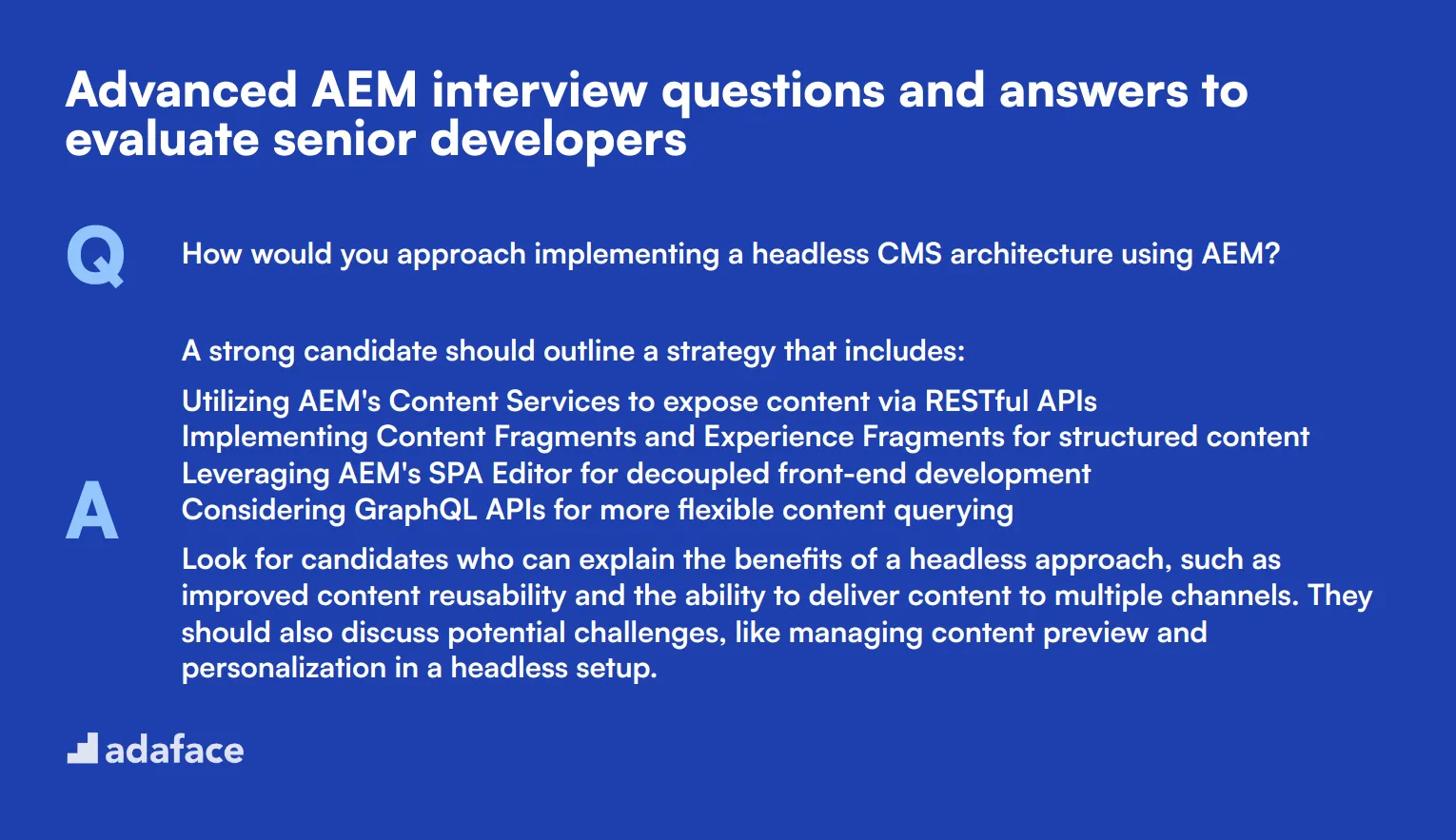
Ready to put your senior AEM developers through their paces? These 7 advanced questions will help you evaluate their deep understanding and problem-solving skills. Use them to uncover how candidates approach complex AEM scenarios and their ability to architect solutions in real-world situations. Remember, it's not just about the answers, but how they articulate their thought process.
1. How would you approach implementing a headless CMS architecture using AEM?
A strong candidate should outline a strategy that includes:
- Utilizing AEM's Content Services to expose content via RESTful APIs
- Implementing Content Fragments and Experience Fragments for structured content
- Leveraging AEM's SPA Editor for decoupled front-end development
- Considering GraphQL APIs for more flexible content querying
Look for candidates who can explain the benefits of a headless approach, such as improved content reusability and the ability to deliver content to multiple channels. They should also discuss potential challenges, like managing content preview and personalization in a headless setup.
2. Can you describe a situation where you had to optimize AEM's author instance performance, and what steps did you take?
An experienced developer might mention:
- Analyzing and optimizing queries using the Query Performance tool
- Implementing efficient indexing strategies
- Optimizing DAM workflows for asset processing
- Tuning JVM parameters and Oak repository settings
- Implementing caching strategies at various levels (browser, Dispatcher, AEM)
Pay attention to candidates who demonstrate a systematic approach to performance optimization. They should be able to explain how they identified bottlenecks, implemented solutions, and measured the impact of their optimizations.
3. How would you implement a custom authentication mechanism in AEM that integrates with an external identity provider?
A comprehensive answer might include:
- Implementing a custom Authentication Handler using the Sling Auth Core module
- Configuring SAML or OAuth integration for Single Sign-On (SSO)
- Extending the default login component to accommodate the custom authentication flow
- Implementing proper session management and token validation
- Considering security aspects like CSRF protection and secure cookie handling
Look for candidates who can discuss the trade-offs between different authentication methods and demonstrate an understanding of security best practices in AEM. They should also be able to explain how they would test and validate the custom authentication mechanism.
4. Describe how you would implement a complex, multi-step form in AEM that includes dynamic field validation and conditional logic.
A strong response might outline the following approach:
- Utilizing AEM Forms or creating custom form components
- Implementing client-side validation using JavaScript and AEM ClientLibs
- Leveraging server-side validation through Sling Models or OSGi services
- Using AEM's dialog framework for authoring complex form structures
- Implementing conditional logic through JavaScript and HTL expressions
Evaluate the candidate's understanding of AEM's component architecture and their ability to create reusable, maintainable form solutions. Look for mentions of accessibility considerations and how they would handle form data persistence and submission.
5. How would you approach implementing a custom search solution in AEM that includes faceted search and personalized results?
An experienced AEM developer might suggest:
- Leveraging Oak Query Builder or QueryBuilder API for efficient search queries
- Implementing custom search predicates for faceted search
- Utilizing AEM's personalization features like ContextHub for user profiling
- Implementing custom indexing strategies to optimize search performance
- Considering the use of external search engines like Elasticsearch for advanced scenarios
Look for candidates who can discuss the trade-offs between different search implementation approaches and demonstrate an understanding of search relevance and performance optimization techniques. They should also be able to explain how they would integrate the search solution with AEM's authoring experience.
6. Can you explain how you would implement a custom workflow in AEM that involves both human tasks and automated system processes?
A comprehensive answer might include:
- Designing the workflow using AEM's workflow editor
- Implementing custom workflow steps as OSGi services
- Creating dialog components for human task interactions
- Utilizing Process Steps for automated tasks
- Implementing proper error handling and reporting mechanisms
- Considering workflow monitoring and administration aspects
Evaluate the candidate's understanding of AEM's workflow capabilities and their ability to design solutions that balance automation with human intervention. Look for mentions of best practices in workflow design, such as modularity and reusability of workflow steps.
7. How would you approach implementing a multi-site, multi-language setup in AEM that shares some common content but also has region-specific variations?
A strong response might outline the following strategy:
- Utilizing AEM's Multi Site Manager (MSM) for content inheritance and synchronization
- Implementing language copy functionality for translations
- Using content fragments and experience fragments for shared content
- Leveraging AEM's template editor for creating region-specific page templates
- Implementing proper content governance and publishing workflows
Look for candidates who can discuss the challenges of managing a complex multi-site setup, such as content synchronization, translation management, and performance considerations. They should also be able to explain how they would structure the content repository to support this architecture efficiently.
12 AEM interview questions about technical aspects
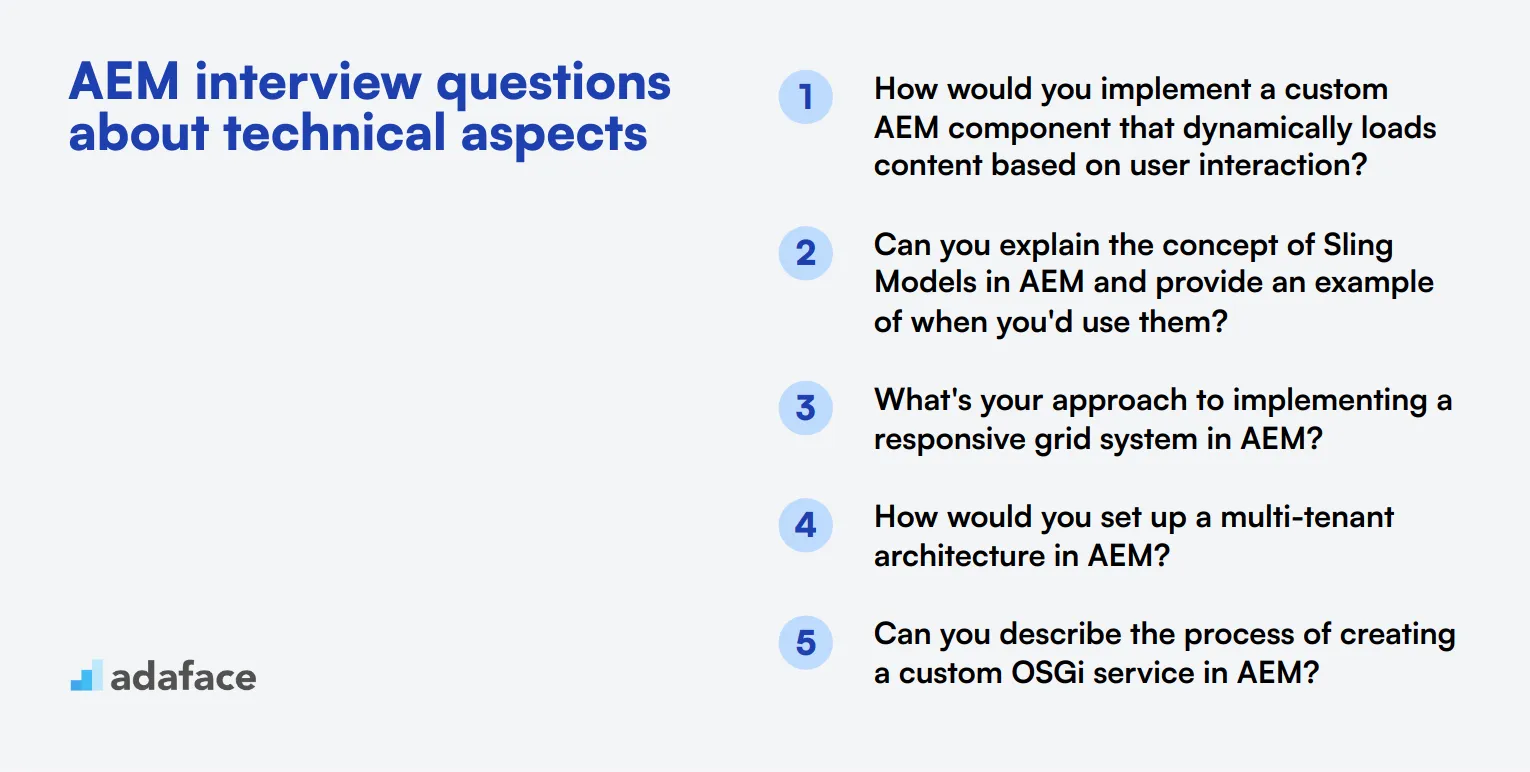
To assess a candidate's technical proficiency in Adobe Experience Manager (AEM), use these 12 interview questions. They're designed to probe deep into a software developer's understanding of AEM's technical aspects, helping you identify top talent for your team.
- How would you implement a custom AEM component that dynamically loads content based on user interaction?
- Can you explain the concept of Sling Models in AEM and provide an example of when you'd use them?
- What's your approach to implementing a responsive grid system in AEM?
- How would you set up a multi-tenant architecture in AEM?
- Can you describe the process of creating a custom OSGi service in AEM?
- How do you handle AEM's touch-enabled UI customization?
- What strategies would you employ for AEM performance tuning in a high-traffic environment?
- How would you implement a custom authentication mechanism in AEM?
- Can you explain the concept of Sling Resource Merger in AEM and its practical applications?
- How would you approach building a headless CMS solution using AEM?
- What's your strategy for managing and deploying AEM packages across different environments?
- How would you implement a custom search functionality in AEM that includes faceted search and personalized results?
Which AEM skills should you evaluate during the interview phase?
While it's impossible to assess every aspect of a candidate's AEM expertise in a single interview, focusing on core skills can provide valuable insights. The following key areas are particularly important when evaluating AEM proficiency.

Content Management
Content management is at the heart of AEM. It involves creating, organizing, and delivering digital content across various channels.
To evaluate this skill, consider asking a targeted question about content management in AEM:
Can you explain how you would set up a content hierarchy in AEM for a multi-language website?
Look for answers that demonstrate understanding of AEM's content structure, language copies, and inheritance. A strong candidate will discuss components, templates, and page properties.
AEM Development
AEM development skills are crucial for customizing and extending the platform. This includes knowledge of HTL, Java, and AEM's API.
To assess AEM development skills, you might ask:
How would you create a custom component in AEM that displays dynamic content based on user preferences?
Listen for explanations involving component creation, dialog configuration, and use of AEM's Java API. Strong candidates may mention best practices for component development.
AEM Architecture
Understanding AEM's architecture is essential for designing scalable and efficient solutions. This includes knowledge of AEM's core concepts and deployment models.
To gauge architectural knowledge, consider asking:
Can you describe the differences between AEM author and publish environments and how they interact?
Look for answers that explain content creation on author instances, replication to publish instances, and the role of the dispatcher. Strong candidates may discuss content workflows and caching strategies.
Hire Top AEM Talent with Skills Tests and Interview Questions
When hiring for AEM positions, it's important to verify that candidates have the required skills. This ensures you find the right fit for your team and project needs.
An effective way to assess AEM skills is through online tests. The Java Online Test and JavaScript Online Test can help evaluate key competencies for AEM development.
After using these tests to shortlist top applicants, you can invite them for interviews. The questions provided in this post will help you dive deeper into their AEM expertise and experience.
Ready to streamline your AEM hiring process? Sign up to access our skills tests and find the best AEM talent for your team.
Java Online Test
Download AEM interview questions template in multiple formats
AEM Interview Questions FAQs
Adobe Experience Manager (AEM) is a comprehensive content management solution for building websites, mobile apps, and forms.
Look for skills like Java, OSGi, JavaScript, HTML, CSS, and experience with AEM's architecture and workflows.
Assess their understanding of core AEM concepts, hands-on experience, and problem-solving abilities through technical questions and practical tests.
AEM skills are crucial for creating and managing digital experiences that engage users and drive business growth.
Prepare questions covering basic concepts, technical skills, practical scenarios, and problem-solving to comprehensively evaluate the candidate.
Common challenges include managing AEM workflows, customizing components, integrating with other systems, and optimizing performance.

40 min skill tests.
No trick questions.
Accurate shortlisting.
We make it easy for you to find the best candidates in your pipeline with a 40 min skills test.
Try for freeRelated posts
Free resources




